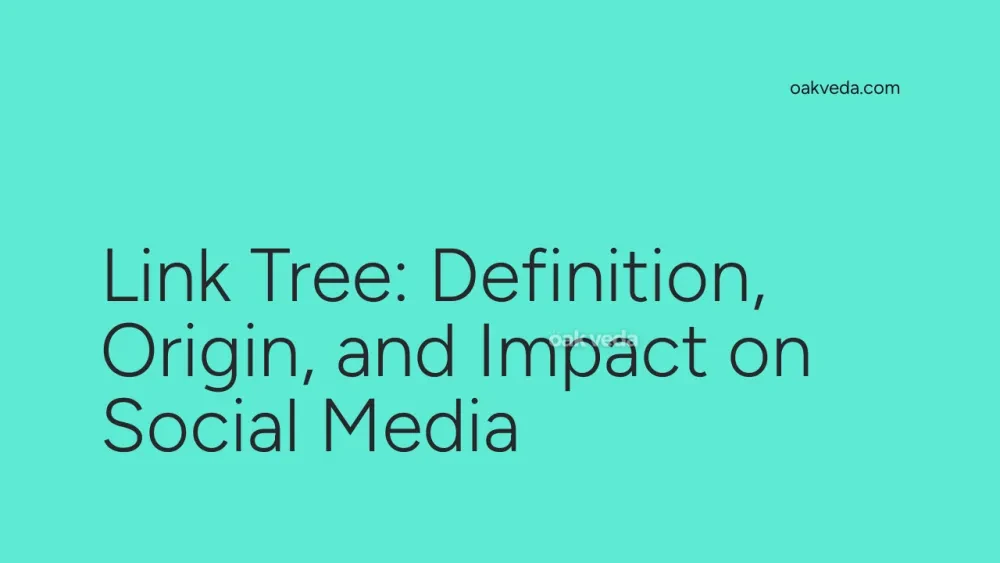
What is a Link Tree?
A link tree is a powerful digital tool that has revolutionized the way social media users share multiple links with their audience. Essentially, it's a landing page that hosts various links, allowing users to direct their followers to multiple destinations using a single URL. This innovation has become particularly crucial for platforms like Instagram, where users are limited to one clickable link in their bio.
Origin and Development of Link Tree
The concept of a link tree emerged as a solution to the growing need for social media users, especially influencers and businesses, to share multiple links with their audience. While the exact origin is not attributed to a single entity, the term "link tree" gained popularity with the launch of Linktree in 2016. Since then, numerous similar services have sprung up, each offering unique features to enhance the link-sharing experience.
How Link Tree Works
Link trees function as a bridge between social media profiles and external content. Here's a step-by-step breakdown of how they typically work:
- Users create an account with a link tree service.
- They customize their landing page with branding elements and add multiple links.
- The service provides a single, short URL that users can add to their social media bios.
- When followers click this URL, they're directed to the customized landing page.
- Visitors can then choose from the various links displayed, accessing different content or websites.
Types or Variations of Link Trees
While the basic concept remains the same, different link tree services offer various features:
- Basic Link Trees: Simple, list-style layouts with clickable buttons.
- Customizable Link Trees: Offer more design options, including color schemes and fonts.
- E-commerce Focused: Integrate with online stores, allowing direct product purchases.
- Analytics-Driven: Provide detailed click-through rates and visitor statistics.
- Social Media Integrations: Automatically update with recent posts or content from connected platforms.
Popular Examples of Link Tree Services
- Linktree: Often credited with popularizing the concept, known for its user-friendly interface.
- Shorby: Offers advanced features like retargeting pixels and email capture.
- Lnk.Bio: Provides a visual grid layout, mimicking Instagram's aesthetic.
- Campsite.bio: Focuses on clean, minimalist designs with robust analytics.
- Later's Link in Bio: Integrates seamlessly with Later's social media scheduling platform, offering unique features like shoppable posts.
Impact of Link Trees on Social Media Culture
Link trees have significantly influenced social media behavior and strategy:
- Simplified Content Sharing: Users can effortlessly direct followers to various platforms or content pieces.
- Enhanced User Experience: Followers can easily navigate to content that interests them most.
- Improved Analytics: Marketers can track which links perform best, refining their strategies.
- Monetization Opportunities: Influencers and businesses can more effectively promote products or affiliate links.
- Cross-Platform Promotion: Users can bridge gaps between different social media platforms and external websites.
How Brands and Influencers Use Link Trees
Link trees have become an essential tool in digital marketing strategies:
- Product Launches: Brands use link trees to showcase new products, reviews, and purchase options.
- Content Promotion: Influencers direct followers to their latest blog posts, videos, or podcast episodes.
- Event Marketing: Organizers provide links to ticket sales, schedules, and venue information.
- Portfolio Showcase: Creatives display their work across various platforms or publications.
- Affiliate Marketing: Influencers organize their affiliate links for easy access and tracking.
Future Trends Related to Link Trees
As social media continues to evolve, so too will link tree technology:
- AI-Powered Personalization: Link trees may use AI to display different links based on user preferences or behavior.
- Increased Interactivity: We might see more interactive elements like mini-games or polls integrated into link trees.
- Augmented Reality Integration: AR features could allow users to "try on" products or preview content before clicking through.
- Enhanced E-commerce Capabilities: Direct purchasing options within link trees may become more sophisticated.
- Improved Analytics and Insights: More detailed data analysis tools will help users optimize their link tree performance.
FAQs about Link Trees
-
Are link trees free to use? Many services offer free basic plans, with premium features available for a fee.
-
Can I use a link tree on any social media platform? Yes, you can share your link tree URL on any platform that allows link sharing.
-
Do link trees affect SEO? While they don't directly impact SEO, they can indirectly boost traffic to your various web properties.
-
How often should I update my link tree? It's best to update your link tree regularly, especially when you have new content or promotions to share.
-
Can I create my own link tree without using a service? Yes, tech-savvy users can create their own landing pages that function as link trees.
Link trees have undoubtedly transformed the way we navigate the digital landscape, offering a simple yet effective solution to the challenge of sharing multiple links on social media. As they continue to evolve, link trees will likely play an increasingly important role in digital marketing strategies, content creation, and user engagement across various online platforms.
You may be interested in:
- Evergreen Content: Definition, Origin, and Impact
- Brand Partnership: Definition, Origin, and Impact
- Social Media Management: Definition, Origin, and Impact
- Lookalike Audience: Definition, Origin, and Impact
- Go Live: Definition, Origin, and Impact on Social Media
- Doing It for the Gram: Definition, Origin, and Impact

